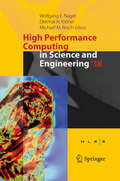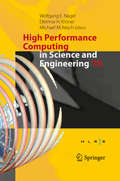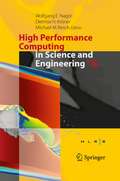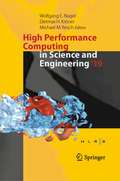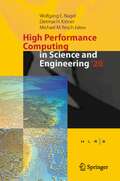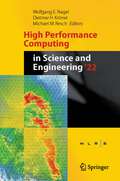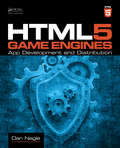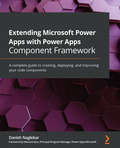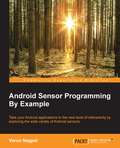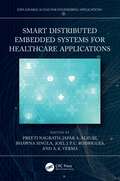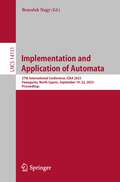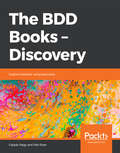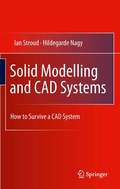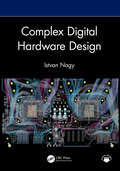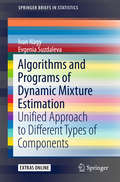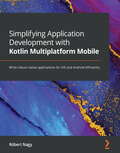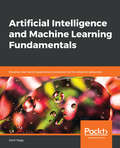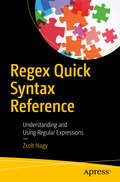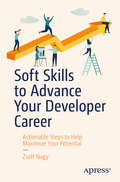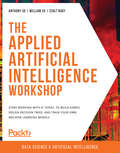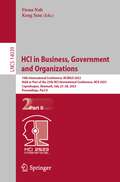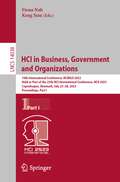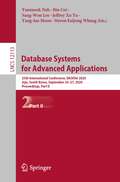- Table View
- List View
High Performance Computing in Science and Engineering ' 18: Transactions of the High Performance Computing Center, Stuttgart (HLRS) 2018
by Wolfgang E. Nagel Dietmar H. Kröner Michael M. ReschThis book presents the state-of-the-art in supercomputer simulation. It includes the latest findings from leading researchers using systems from the High Performance Computing Center Stuttgart (HLRS) in 2018. The reports cover all fields of computational science and engineering ranging from CFD to computational physics and from chemistry to computer science with a special emphasis on industrially relevant applications. Presenting findings of one of Europe’s leading systems, this volume covers a wide variety of applications that deliver a high level of sustained performance.The book covers the main methods in high-performance computing. Its outstanding results in achieving the best performance for production codes are of particular interest for both scientists and engineers. The book comes with a wealth of color illustrations and tables of results.
High Performance Computing in Science and Engineering ´15: Transactions of the High Performance Computing Center, Stuttgart (HLRS) 2015
by Wolfgang E. Nagel Dietmar H. Kröner Michael M. ReschThis book presents the state-of-the-art in supercomputer simulation. It includes the latest findings from leading researchers using systems from the High Performance Computing Center Stuttgart (HLRS) in 2015. The reports cover all fields of computational science and engineering ranging from CFD to computational physics and from chemistry to computer science with a special emphasis on industrially relevant applications. Presenting findings of one of Europe’s leading systems, this volume covers a wide variety of applications that deliver a high level of sustained performance. The book covers the main methods in high-performance computing. Its outstanding results in achieving the best performance for production codes are of particular interest for both scientists and engineers. The book comes with a wealth of color illustrations and tables of results.
High Performance Computing in Science and Engineering ´16
by Wolfgang E. Nagel Dietmar H. Kröner Michael M. ReschThis book presents the state-of-the-art in supercomputer simulation. It includes the latest findings from leading researchers using systems from the High Performance Computing Center Stuttgart (HLRS) in 2016. The reports cover all fields of computational science and engineering ranging from CFD to computational physics and from chemistry to computer science with a special emphasis on industrially relevant applications. Presenting findings of one of Europe's leading systems, this volume covers a wide variety of applications that deliver a high level of sustained performance. The book covers the main methods in high-performance computing. Its outstanding results in achieving the best performance for production codes are of particular interest for both scientists and engineers. The book comes with a wealth of color illustrations and tables of results.
High Performance Computing in Science and Engineering ´16: Transactions of the High Performance Computing Center, Stuttgart (HLRS) 2016
by Wolfgang E. Nagel Dietmar H. Kröner Michael M. ReschThis book presents the state-of-the-art in supercomputer simulation. It includes the latest findings from leading researchers using systems from the High Performance Computing Center Stuttgart (HLRS) in 2016. The reports cover all fields of computational science and engineering ranging from CFD to computational physics and from chemistry to computer science with a special emphasis on industrially relevant applications. Presenting findings of one of Europe’s leading systems, this volume covers a wide variety of applications that deliver a high level of sustained performance.The book covers the main methods in high-performance computing. Its outstanding results in achieving the best performance for production codes are of particular interest for both scientists and engineers. The book comes with a wealth of color illustrations and tables of results.
High Performance Computing in Science and Engineering '19: Transactions of the High Performance Computing Center, Stuttgart (HLRS) 2019
by Wolfgang E. Nagel Dietmar H. Kröner Michael M. ReschThis book presents the state-of-the-art in supercomputer simulation. It includes the latest findings from leading researchers using systems from the High Performance Computing Center Stuttgart (HLRS) in 2019. The reports cover all fields of computational science and engineering ranging from CFD to computational physics and from chemistry to computer science with a special emphasis on industrially relevant applications. Presenting findings of one of Europe’s leading systems, this volume covers a wide variety of applications that deliver a high level of sustained performance.The book covers the main methods in high-performance computing. Its outstanding results in achieving the best performance for production codes are of particular interest for both scientists and engineers. The book comes with a wealth of color illustrations and tables of results.
High Performance Computing in Science and Engineering '20: Transactions of the High Performance Computing Center, Stuttgart (HLRS) 2020
by Wolfgang E. Nagel Dietmar H. Kröner Michael M. ReschThis book presents the state-of-the-art in supercomputer simulation. It includes the latest findings from leading researchers using systems from the High Performance Computing Center Stuttgart (HLRS) in 2020. The reports cover all fields of computational science and engineering ranging from CFD to computational physics and from chemistry to computer science with a special emphasis on industrially relevant applications. Presenting findings of one of Europe’s leading systems, this volume covers a wide variety of applications that deliver a high level of sustained performance.The book covers the main methods in high-performance computing. Its outstanding results in achieving the best performance for production codes are of particular interest for both scientists and engineers. The book comes with a wealth of color illustrations and tables of results.
High Performance Computing in Science and Engineering '22: Transactions of the High Performance Computing Center, Stuttgart (HLRS) 2022
by Wolfgang E. Nagel Dietmar H. Kröner Michael M. ReschThis book presents the state-of-the-art in supercomputer simulation. It includes the latest findings from leading researchers using systems from the High Performance Computing Center Stuttgart (HLRS) in 2022. The reports cover all fields of computational science and engineering ranging from CFD to computational physics and from chemistry to computer science with a special emphasis on industrially relevant applications. Presenting findings of one of Europe’s leading systems, this volume covers a wide variety of applications that deliver a high level of sustained performance.The book covers the main methods in high-performance computing. Its outstanding results in achieving the best performance for production codes are of particular interest for both scientists and engineers. The book comes with a wealth of color illustrations and tables of results.
High Performance Computing in Science and Engineering ‘12
by Wolfgang E. Nagel Michael M. Resch Dietmar H. KrönerThis book presents the state-of-the-art in simulation on supercomputers. Leading researchers present results achieved on systems of the High Performance Computing Center Stuttgart (HLRS) for the year 2012. The reports cover all fields of computational science and engineering ranging from CFD via computational physics and chemistry to computer science with a special emphasis on industrially relevant applications. Presenting results for both vector-systems and micro-processor based systems the book allows to compare performance levels and usability of various architectures. As HLRS operates not only a large cluster system but also one of the largest NEC vector systems in the world this book gives an excellent insight also into the potential of vector systems. The book covers the main methods in high performance computing. Its outstanding results in achieving highest performance for production codes are of particular interest for both the scientist and the engineer. The book comes with a wealth of coloured illustrations and tables of results.
HTML5 Game Engines: App Development and Distribution
by Dan NagleThis book is an introduction to development with HTML5 game engines, an in-depth look at some popular engines, downloadable example projects for each engine, and techniques on how to package and distribute the final app to all the major platforms.
Extending Microsoft Power Apps with Power Apps Component Framework: A complete guide to creating, deploying, and improving your code components
by Danish Naglekar Hemant GaurLearn how to extend the capabilities of Power Apps by building code components using Power Apps Component FrameworkKey FeaturesUnderstand how to extend Power Apps' capabilitiesEnhance your skills with the help of practical code components used throughout the bookOvercome common challenges, avoid pitfalls, and improve your codeBook DescriptionPower Apps Component Framework is used by professional developers to extend the capabilities of model-driven and canvas apps. Extending Microsoft Power Apps with Power Apps Component Framework will take you through the basic as well as advanced topics using practical examples. The book starts by helping you understand the fundamentals of the framework, its lifecycle, and the tools that you'll use to build code components using best practices and file management guidelines. You'll then learn how to extend Power Apps step by step and apply the principles and concepts covered in the book to build code components for field type attributes. The book covers different ways of debugging code components and guides you through the process of building code components for datasets. You'll also explore the functions and methods provided by the framework to enhance your controls using powerful sets of libraries and extensions. As you advance, you'll get to grips with creating and managing authentication profiles, discover different ways of deploying code components, and configure code components in model-driven and canvas apps. Finally, you'll learn some of the important features of the framework and learn modern web development practices. By the end of this Power Apps book, you'll be able to build, debug, enrich, and deploy code components confidently.What you will learnUnderstand the fundamentals of Power Apps Component FrameworkExplore the tools that make it easy to build code componentsBuild code components for both a field and a datasetDebug using test harness and FiddlerImplement caching techniquesFind out how to work with the Dataverse Web APIBuild code components using React and Fluent UI controlsDiscover different deployment strategiesWho this book is forThis book is for developers who are looking to build advanced skills for extending the capabilities of Power Apps. Basic knowledge of Power Apps and web development is necessary to get started with this book.
Android Sensor Programming By Example
by Varun NagpalTake your Android applications to the next level of interactivity by exploring the wide variety of Android sensors About This Book * Get a thorough understanding of the fundamentals and framework of Android sensors. * Acquire knowledge of advance sensor programming, and learn how to connect and use sensors in external devices such as the Android Watch, Polar heart rate monitors, Adidas speed cells, and so on. * Learn from real-world sensor-based applications such as the Pedometer app to detect daily steps, the Driving app to detect driving events, and the Professional Fitness tracker app to track heart rate, weight, daily steps, calories burned, and so on. Who This Book Is For This book is targeted at Android developers who want to get a good understanding of sensors and write sensor-based applications, or who want to enhance their existing applications with additional sensor functionality. A basic knowledge of Android development is required What You Will Learn * Learn about sensor fundamentals, different types of sensors, and the sensor co-ordinate system * Understand the various classes, callbacks, and APIs of the Android Sensor framework * Check all the available sensors on an Android device and know their individual capabilities--for example, their range of values, power consumption, and so on. * Implement sensor fusion using two or more sensors together and learn to compensate for the weakness of one sensor by using the strength of another * Build a variety of sensor based, real-world applications such as Weather, Pedometer, Compass, Driving Events Detection, Fitness Tracker, and so on. * Get to know about wake up and non-wake up sensors, wake locks, and how to use sensor batch processing along with the sensor hardware FIFO queue * Develop efficient battery and processor algorithms using raw sensor data to solve real-world problems * Connect to a variety of remote sensors such as body weight measurement and body fat percentage measurement using the Google Fit platform from your Android app In Detail Android phones available in today's market have a wide variety of powerful and highly precise sensors. Interesting applications can be built with them such as a local weather app using weather sensors, analyzing risky driving behavior using motion sensors, a fitness tracker using step-counter sensors, and so on. Sensors in external devices such as Android Watch, Body Analyzer & Weight Machine, Running Speed Cell, and so on can also be connected and used from your Android app running on your phone. Moving further, this book will provide the skills required to use sensors in your Android applications. It will walk you through all the fundamentals of sensors and will provide a thorough understanding of the Android Sensor Framework. You will also get to learn how to write code for the supportive infrastructure such as background services, scheduled and long running background threads, and databases for saving sensor data. Additionally, you will learn how to connect and use sensors in external devices from your Android app using the Google Fit platform. By the end of the book, you will be well versed in the use of Android sensors and programming to build interactive applications. Style and approach A step-by-step and easy-to-follow guide that focuses on utilizing sensors to perform certain tasks. After covering the fundamentals in the first chapter, the book develops the concepts by building a real-world, sensor-based application in subsequent chapters.
Smart Distributed Embedded Systems for Healthcare Applications (Explainable AI (XAI) for Engineering Applications)
by Preeti Nagrath Jafar A. Alzubi Bhawna Singla Joel J. P. C. Rodrigues A. K. VermaThis book discusses the applications and optimization of emerging smart technologies in the field of healthcare. It further explains different modeling scenarios of the latest technologies in the healthcare system and compares the results to better understand the nature and progress of diseases in the human body, which would ultimately lead to early diagnosis and better treatment and cure of diseases with the help of distributed technology. Covers the implementation models using technologies such as artificial intelligence, machine learning, and deep learning with distributed systems for better diagnosis and treatment of diseases. Gives in-depth review of technological advancements like advanced sensing technologies such as plasmonic sensors, usage of RFIDs, and electronic diagnostic tools in the field of healthcare engineering. Discusses possibilities of augmented reality and virtual reality interventions for providing unique solutions in medical science, clinical research, psychology, and neurological disorders. Highlights the future challenges and risks involved in the application of smart technologies such as cloud computing, fog computing, IOT, and distributed computing in healthcare. Confers to utilize the AI and ML and associated aids in healthcare sectors in the post-Covid 19 period to revitalize the medical setup. Contributions included in the book will motivate technological developers and researchers to develop new algorithms and protocols in the healthcare field. It will serve as a vast platform for gaining knowledge regarding healthcare delivery, health- care management, healthcare in governance, and health monitoring approaches using distributed environments. It will serve as an ideal reference text for graduate students and researchers in diverse engineering fields including electrical, electronics and communication, computer, and biomedical fields.
Implementation and Application of Automata: 27th International Conference, CIAA 2023, Famagusta, North Cyprus, September 19–22, 2023, Proceedings (Lecture Notes in Computer Science #14151)
by Benedek NagyThis book constitutes the proceedings of the 27th International Conference on Implementation and Application of Automata, CIAA 2023, held in Famagusta, North Cyprus, during September 19–22, 2023. The 20 regular papers presented in this book together with invited talks were carefully reviewed and selected from 30 submissions. The topics of the papers cover various fields in the application, implementation, and theory of automata and related structures.
The BDD Books - Discovery: Explore behavior using examples
by Gaspar Nagy Seb RoseGet the most out of the discovery phase of Behavior Driven Development (BDD) Key Features Get a comprehensive overview of the discovery phase and see where it fits into BDD Learn specific technical practices needed to successfully drive development Gain insight into how to use BDD in almost any project – not just agile approaches Book Description Behavior-Driven Development (BDD) is an agile approach to software development that insists that detailed requirements for a feature should be defined collaboratively by the business and delivery teams. This book explores, in detail, the collaborative aspect of BDD. The book starts by explaining the need for BDD and describes techniques for getting the most out of the collaboration between the delivery team (those that implement the solution) and the business team (those that work on the requirements). You'll also learn how BDD can be integrated into the development process and answer some common questions, such as “Who should write the scenarios?" and “Should the testers or the developers automate the scenarios?” The last chapters discuss how to use BDD in agile and fixed-price projects and how to involve your business partners in your projects. By the end of the book, you'll have discovered the importance of collaboration and learned techniques to effectively implement these ideas in your software development lifecycle. What you will learn Explore why BDD exists, what challenges it addresses, and how it works Establish structured conversations to finalize requirements Discover techniques to form concrete examples that clearly list requirements Gain insight into the tasks involved while following the BDD approach Get good automated test coverage by tightly connecting tests and scenarios Develop scenarios to get a functional breakdown of a story Who this book is for This book is written for everyone involved in the specification and delivery of software (including product owners, business analysts, developers, and testers). This book is aimed at everyone involved in the project, irrespective of your role, whether you come from a software background or not.
Solid Modelling and CAD Systems
by Hildegarde Nagy Ian StroudSolid Modelling and CAD Systems gives users an insight into the methods and problems associated with CAD systems. It acts as a bridge between users who learn interfaces without understanding how they work and developers who create systems without understanding the needs of the users. The main feature of Solid Modelling and CAD Systems is a logical analysis of the techniques and basic solid modelling methods used in modern CAD systems. The book goes on to describe, among other subjects: two-dimensional shape definition methods,the command interface and graphics,databases and data exchange,early-phase design, andcommand files and command structures. Reading Solid Modelling and CAD Systems will help users understand the limitations of the techniques they are using and will enable practitioners to use CAD systems more efficiently. It is a valuable tool for designers, as well as for advanced undergraduate and postgraduate students. The exercises it contains allow readers to try out different aspects of the subject matter and the book also includes projects that can be used for teaching purposes.
Complex Digital Hardware Design
by Istvan NagyThis book is about how to design the most complex types of digital circuit boards used inside servers, routers and other equipment, from high-level system architecture down to the low-level signal integrity concepts. It explains common structures and subsystems that can be expanded into new designs in different markets.The book is targeted at all levels of hardware engineers. There are shorter, lower-level introductions to every topic, while the book also takes the reader all they way to the most complex and most advanced topics of digital circuit design, layout design, analysis, and hardware architecture.
Algorithms and Programs of Dynamic Mixture Estimation: Unified Approach to Different Types of Components (SpringerBriefs in Statistics)
by Ivan Nagy Evgenia SuzdalevaThis book provides a general theoretical background for constructing the recursive Bayesian estimation algorithms for mixture models. It collects the recursive algorithms for estimating dynamic mixtures of various distributions and brings them in the unified form, providing a scheme for constructing the estimation algorithm for a mixture of components modeled by distributions with reproducible statistics. It offers the recursive estimation of dynamic mixtures, which are free of iterative processes and close to analytical solutions as much as possible. In addition, these methods can be used online and simultaneously perform learning, which improves their efficiency during estimation. The book includes detailed program codes for solving the presented theoretical tasks. Codes are implemented in the open source platform for engineering computations. The program codes given serve to illustrate the theory and demonstrate the work of the included algorithms.
Simplifying Application Development with Kotlin Multiplatform Mobile: Write robust native applications for iOS and Android efficiently
by Robert NagyExplore the new Kotlin Multiplatform to build native apps for Android and iOS while sharing business logic between appsKey FeaturesImprove app development speed dramatically by writing the business logic in KotlinImplement a native user interface and work with platform-specific APIsLeverage Kotlin Multiplatform Mobile's code-sharing capabilities for your projectsBook DescriptionSharing code between platforms can help developers gain a competitive edge, and Kotlin Multiplatform Mobile (KMM) offers a sensible way to do it. KMM helps mobile teams share code between Android and iOS in a flexible way, leaving room for native development.The book begins by helping you to gain a clear understanding of the Kotlin Multiplatform approach, how it works, and how it is different from cross-platform technologies, such as React Native and Flutter, and code sharing options, such as C++. You'll then see how your team can use this software development kit (SDK) to build native applications more effectively by learning timeless concepts and working through practical examples. As you advance, you'll get to grips with the core concepts, understand why UI sharing fails, and get hands-on with developing a small KMM application. Finally, you'll discover expert tips and best practices, along with production- and adoption-related questions, that will help you take the next step in your project and career.By the end of this Kotlin book, you'll have gained a solid understanding of the capabilities of KMM and be able to share code between Android and iOS flexibly.What you will learnGet acquainted with the multiplatform approach and KMM's competitive edgeUnderstand how Kotlin Multiplatform works under the hoodGet up and running with the Kotlin language quickly in the context of SwiftFind out how to share code between Android and iOSExplore tips and best practices in KMM to increase app development efficiencyDiscover adoption tips to integrate KMM into existing or new production appsWho this book is forThis book is for native Android and iOS developers who want to build high-quality apps using an efficient development process. Knowledge of the framework and the languages used is necessary, that is, Android with Java or Kotlin and iOS with Objective-C or Swift. For Swift developers, the book assumes no knowledge of Kotlin as this will be covered in the context of Swift.
Beginning AI, Machine Learning and Python
by Zsolt NagyThis book is ideal for software developers and data scientists, who want to enrich their projects with machine learning. You do not need any prior experience in AI. We recommend that you have knowledge of high school level mathematics and at least one programming language, preferably Python.
Regex Quick Syntax Reference: Understanding and Using Regular Expressions
by Zsolt NagyThis quick guide to regular expressions is a condensed code and syntax reference for an important programming technique. It demonstrates regex syntax in a well-organized format that can be used as a handy reference, showing you how to execute regexes in many languages, including JavaScript, Python, Java, and C#.The Regex Quick Syntax Reference features short, focused code examples that show you how to use regular expressions to validate user input, split strings, parse input, and match patterns. Utilizing regular expressions to deal with search/replace and filtering data for backend coding is also covered. You won’t find any bloated samples, drawn out history lessons, or witty stories in this book. What you will find is a language reference that is concise and highly accessible. The book is packed with useful information and is a must-have for any programmer.What You Will LearnFormulate an expressionWork with arbitrary char classes, disjunctions, and operator precedenceExecute regular expressions and visualize using finite state machinesDeal with modifiers, including greedy and lazy loops Handle substring extraction from regex using Perl 6 capture groups, capture substrings, and reuse substrings Who This Book Is ForIf you have dealt with at least one programming language, chances are you know enough to understand regular expressions, and the examples in this book will help you develop proficiency.
Soft Skills to Advance Your Developer Career: Actionable Steps to Help Maximize Your Potential
by Zsolt NagyAs a software developer, your technical skill set is in high demand. Devices and technology have become an integral part of our everyday lives and no digital organization can thrive without technical professionals on the payroll. However, career plateaus are inevitable in even the most high-demand field. Companies do not only need software developers; they need software developers with soft skills.In Soft Skills to Advance Your Developer Career, author Zsolt Nagy explores how emotional intelligence can give your software development career an edge. These subjects are not taught in school, and unfortunately the career advancement of many excellent developers can be blocked by their inability to effectively communicate their needs, assert themselves, and negotiate confidently. Throughout this book, Nagy shows you how to actively improve and prioritize your soft skills so that you can better represent the holistic interests of your team, obtain better working conditions, negotiate raises, and increase your variety of employment options by elevating your interviewing skills.Discover the obstacles standing between you and a fulfilling career by finding and improving strengths you may not have even known you had. Jump out of your box with Soft Skills to Advance Your Developer Career and leverage your expertise with effortless confidence at all stages of your professional journey.What You Will LearnExamine why software developer careers cannot be treated similarly as any other career pathUnderstand the four soft-skills you need to advance your careerDevelop a strategy for your personal brand and align it with your career planRealize the role of assertive communication, and the importance of giving and receiving feedbackCreate a plan for setting yourself up for a raise or promotionDiscover techniques for acing the behavioral and coding interview Who This Book Is ForSoftware developers who have the technical skills required for career advancement, but want a guide on how to manage their careers
The Applied Artificial Intelligence Workshop: Start working with AI today, to build games, design decision trees, and train your own machine learning models
by Zsolt Nagy Anthony So William SoWith knowledge and information shared by experts, take your first steps towards creating scalable AI algorithms and solutions in Python, through practical exercises and engaging activities Key Features Learn about AI and ML algorithms from the perspective of a seasoned data scientist Get practical experience in ML algorithms, such as regression, tree algorithms, clustering, and more Design neural networks that emulate the human brain Book Description You already know that artificial intelligence (AI) and machine learning (ML) are present in many of the tools you use in your daily routine. But do you want to be able to create your own AI and ML models and develop your skills in these domains to kickstart your AI career? The Applied Artificial Intelligence Workshop gets you started with applying AI with the help of practical exercises and useful examples, all put together cleverly to help you gain the skills to transform your career. The book begins by teaching you how to predict outcomes using regression. You'll then learn how to classify data using techniques such as k-nearest neighbor (KNN) and support vector machine (SVM) classifiers. As you progress, you'll explore various decision trees by learning how to build a reliable decision tree model that can help your company find cars that clients are likely to buy. The final chapters will introduce you to deep learning and neural networks. Through various activities, such as predicting stock prices and recognizing handwritten digits, you'll learn how to train and implement convolutional neural networks (CNNs) and recurrent neural networks (RNNs). By the end of this applied AI book, you'll have learned how to predict outcomes and train neural networks and be able to use various techniques to develop AI and ML models. What you will learn Create your first AI game in Python with the minmax algorithm Implement regression techniques to simplify real-world data Experiment with classification techniques to label real-world data Perform predictive analysis in Python using decision trees and random forests Use clustering algorithms to group data without manual support Learn how to use neural networks to process and classify labeled images Who this book is for The Applied Artificial Intelligence Workshop is designed for software developers and data scientists who want to enrich their projects with machine learning. Although you do not need any prior experience in AI, it is recommended that you have knowledge of high school-level mathematics and at least one programming language, preferably Python. Although this is a beginner's book, experienced students and programmers can improve their Python skills by implementing the practical applications given in this book.
HCI in Business, Government and Organizations: 10th International Conference, HCIBGO 2023, Held as Part of the 25th HCI International Conference, HCII 2023, Copenhagen, Denmark, July 23–28, 2023, Proceedings, Part II (Lecture Notes in Computer Science #14039)
by Fiona Nah Keng SiauThis two-volume set of HCIBGO 2023, constitutes the refereed proceedings of the 10h International Conference on HCI in Business, Government and Organizations, held as Part of the 24th International Conference, HCI International 2023, which took place in July 2023 in Copenhagen, Denmark.The total of 1578 papers and 396 posters included in the HCII 2023 proceedings volumes was carefully reviewed and selected from 7472 submissions. The HCIBGO 2023 proceedings focuses in topics such as artificial intelligence and machine learning, blockchain, service design, live streaming in electronic commerce, visualization, and workplace design.
HCI in Business, Government and Organizations: 10th International Conference, HCIBGO 2023, Held as Part of the 25th HCI International Conference, HCII 2023, Copenhagen, Denmark, July 23–28, 2023, Proceedings, Part I (Lecture Notes in Computer Science #14038)
by Fiona Nah Keng SiauThis two-volume set of HCIBGO 2023, constitutes the refereed proceedings of the 10h International Conference on HCI in Business, Government and Organizations, held as Part of the 24th International Conference, HCI International 2023, which took place in July 2023 in Copenhagen, Denmark.The total of 1578 papers and 396 posters included in the HCII 2023 proceedings volumes was carefully reviewed and selected from 7472 submissions. The HCIBGO 2023 proceedings focuses in topics such as artificial intelligence and machine learning, blockchain, service design, live streaming in electronic commerce, visualization, and workplace design.
Database Systems for Advanced Applications: 25th International Conference, DASFAA 2020, Jeju, South Korea, September 24–27, 2020, Proceedings, Part II (Lecture Notes in Computer Science #12113)
by Yunmook Nah Bin Cui Sang-Won Lee Jeffrey Xu Yu Yang-Sae Moon Steven Euijong WhangThe 4 volume set LNCS 12112-12114 constitutes the papers of the 25th International Conference on Database Systems for Advanced Applications which will be held online in September 2020. The 119 full papers presented together with 19 short papers plus 15 demo papers and 4 industrial papers in this volume were carefully reviewed and selected from a total of 487 submissions. The conference program presents the state-of-the-art R&D activities in database systems and their applications. It provides a forum for technical presentations and discussions among database researchers, developers and users from academia, business and industry.
